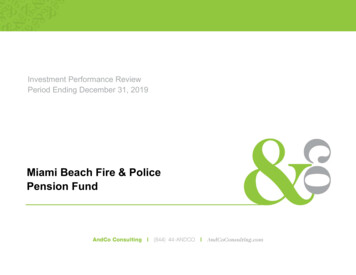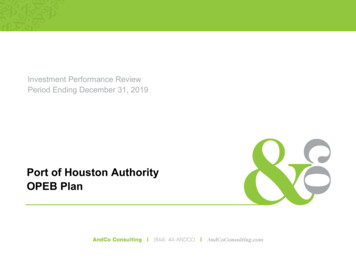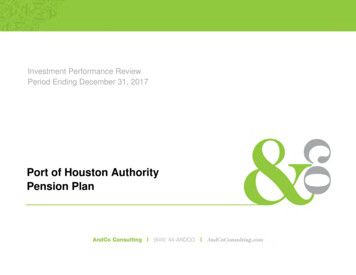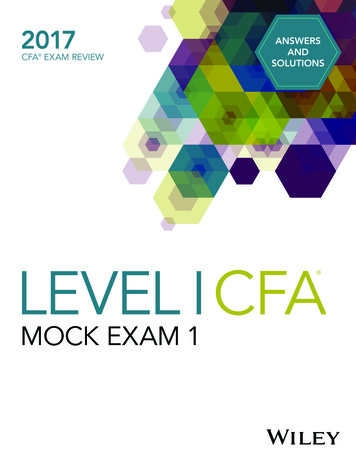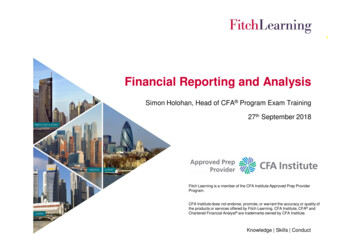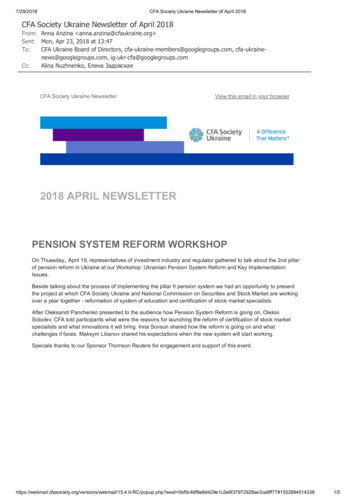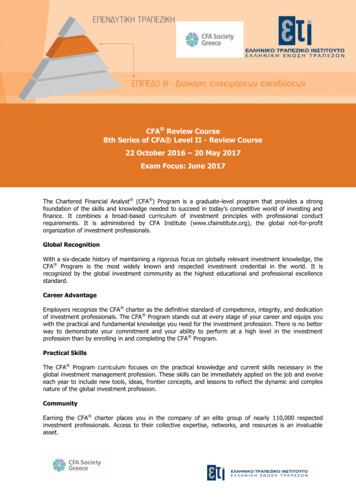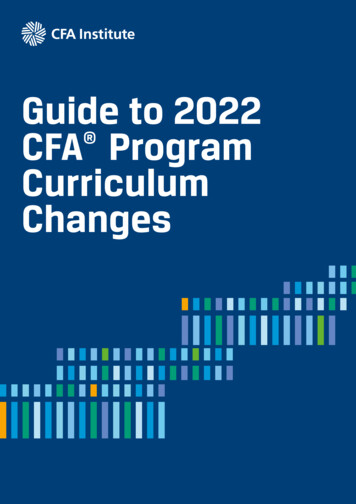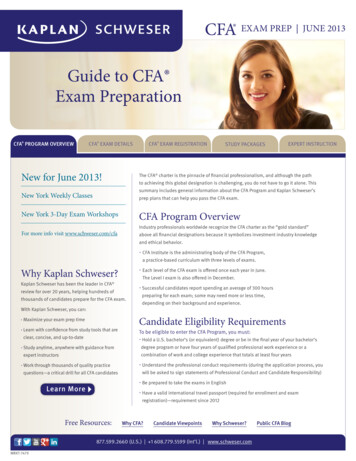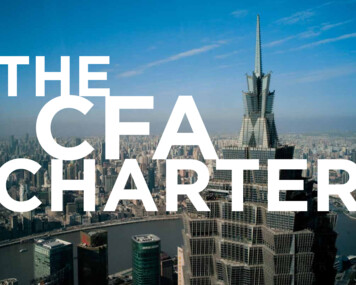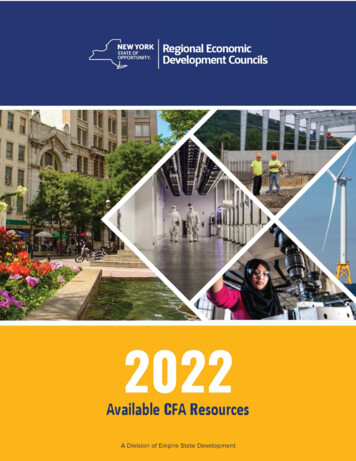
Transcription
Regional EconomicDevelopment CouncilsAvailable CFA ResourcesA Division of Empire State Development
Table of ContentsTable of Contents . 1Introduction. 22022 Available Resources . 4Empire State Development . 5Empire State Development Grant Funds . 5Excelsior Jobs Program . 12New York State Business Incubator and Innovation Hot Spot Support Program. 17Market New York . 21New York State Department of Agriculture and Markets . 33NYS Grown & Certified Infrastructure, Technology, Research and Development Grant Program 33Homes and Community Renewal: Up to 4.2 million . 38New York Main Street Program . 38Office of Parks, Recreation & Historic Preservation (OPRHP) . 48Environmental Protection Fund Grants Program for Parks, Preservation and Heritage (EPF) . 48Department of State . 65Local Waterfront Revitalization Program . 65Brownfield Opportunity Area Program . 73New York State Canal Corporation . 83Canalway Grants Program . 83New York State Energy Research and Development Authority. 88NYSERDA Carbon Neutral Community Economic Development . 88NYSERDA Commercial and Industrial (C&I) Carbon Challenge . 102New York Power Authority . 108ReCharge New York . 1081
IntroductionThe Regional Economic Development Councils (REDC) and the Consolidated Funding Application(CFA) were created to advance efforts to improve New York’s business climate and expandeconomic growth. The REDCs support the state’s innovative approach to economic development,which empowers regional stakeholders to establish pathways to prosperity, mapped out in regionalstrategic plans.New York State drives economic growth by making investments that enforce four interconnectingstrategies: Placemaking - The notion that where investment occurs matters. In order to attract atalented workforce, our built environment must emphasize creating accessible job centers,sustainable infrastructure, and livable communities.Workforce - The belief that people drive the economy. Targeted job training and educationensures that jobs in high-paying, in-demand, tradeable sectors are filled in an equitable way.Tradeable Sectors - The industries New York State is targeting to increase export basedemployment opportunities. They are the industry sectors that are part of a global market likemanufacturing, agricultural products, and energy.Innovation - The strategy of investing in and creating synergies between research andcommercialization to drive the economy forward.Over the past eleven years, the Regional Councils have revitalized the state’s economy through abottom-up, community-based, and performance-driven approach to economic development.Through the comprehensive strategic planning process, every region across the state hassucceeded in creating private sector jobs, driving private investment, bolstering workforcedevelopment, and revitalizing long-neglected cities, towns, and neighborhoods. This year, theexpertise of the Councils will continue to be an essential component of the post-COVID recoveryalong with a specific focus on determining workforce development needs resulting from thepandemic.The unprecedented economic devastation caused by COVID-19 has highlighted the importance ofinclusive growth and resilient strategies. Public, private, and civic collaboration has been thecornerstone of this process since its inception and the partnerships forged through the RegionalEconomic Development Councils will be vital to the recovery of New York’s economy. Each region’sstrategic plan and progress reports can be found online at www.regionalcouncils.ny.govFor Round XII, Regional Councils will once again focus on the implementation of each region’sstrategic plan, and continue to identify and invest in significant economic development projects.Round XII includes core capital and tax-credit funding that will be combined with a wide range ofexisting agency programs. The core funding includes 225 million in grants and tax credits, to fundhigh value regional priority projects, as well as additional funding from state agencies available tosupport community revitalization and business growth consistent with the existing REDC plansthrough the CFA process.In order to be responsive to the immediate needs of the development community and as the state ismaking crucial investments to generate economic activity, the 150 million in grant funds fromEmpire State Development will continue to be made available to projects on a continuous andcompetitive basis this round.This year, there are programs available through 8 state agencies, including Empire StateDevelopment; NYS Canal Corporation; NYS Energy Research and Development Authority; Homesand Community Renewal; New York Power Authority; Office of Parks, Recreation and Historic2
Preservation; NYS Department of Agriculture and Markets; and Department of State. In an effort toprovide the most appropriate state resources through this process, participating agencies will beable to review and potentially provide funding to a project that did not specifically apply to thatprogram, if the materials submitted at time of application satisfy the requirements for that programand allow for fair review under the circumstances. In addition, all programs contained in thisdocument will use regional distribution standards to ensure projects are funded throughout the state.Please be advised that all CFA grants are subject to the New York State Executive Law Article 15-Awhich requires, where applicable, the establishment of 30% minority-and women-owned businessenterprises ("M/WBE") contract goals.In 2014, the Service-Disabled Veteran-Owned Business Act was signed into law. The new lawcreated the Division of Service-Disabled Veterans’ Business Development in Office of GeneralServices to certify, promote and encourage economic development among disabled veteransthroughout the state. Project applicants are urged to work with Service-Disabled Veteran-OwnedBusinesses (SDVOBs) and a directory can be found at https://ogs.ny.gov/Veterans.This document outlines information about each agency’s grant programs, including eligibility, scoringcriteria, applicant requirements, and agency contact information for programs that are part of theREDC Initiative for Round XII. Additional programs continue to be made available through theConsolidated Funding Application and can be found at: https://apps.cio.ny.gov/apps/cfa/index.cfm3
2022 Available ResourcesPrograms Subject to the 4:00PM July 29 DeadlineEmpire State Development: Up to 23.125 million Up to 15 million for Market New YorkUp to 8.125 million for Business Incubator ProgramHomes and Community Renewal: Up to 4.2 million Up to 4.2 million for New York Main Street ProgramOffice of Parks, Recreation and Historic Preservation: Up to 20.875 million Up to 20.875 million for Environmental Protection Fund Grants Program for Parks, Preservationand Heritage (EPF)Department of State: Up to 20.3 million Up to 16.3 million for the Local Waterfront Revitalization ProgramUp to 4 million for the Brownfield Opportunity Area ProgramNew York State Canal Corporation: Up to 1 million Up to 1 million for the Canalway Grants ProgramNew York State Energy Research and Development Authority: Up to 25 million Up to 15 million for Commercial and Industrial (C&I) Carbon ChallengeUp to 10 million for Carbon Neutral Economic Development ProgramNew York State Department of Agriculture and Markets: Up to 5.8 million Up to 5.8 million for the New York State Grown & Certified Infrastructure, Technology, Researchand Development Grant ProgramOpen Enrollment ProgramsEmpire State Development: Up to 225 million Up to 150 million for ESD Grant FundsUp to 75 million for Excelsior Jobs ProgramNew York State Power Authority: Up to 17.9 Megawatts Up to 17.9 Megawatts for the ReCharge NY ProgramPrograms included as Open Enrollment will continue to accept applications on an ongoing basis and arenot subject to the July 29 deadline4
Empire State DevelopmentEmpire State Development Grant FundsFunding Available: Up to 150 millionDESCRIPTION:ESD has 150 million of capital grant funding from the Regional Council Capital Fund available for theState’s Regional Economic Development Council Initiative, which helps drive regional and localeconomic development across New York State in cooperation with ten Regional EconomicDevelopment Councils (“Regional Councils”).Capital grant funding is available for capital-based economic development projects intended to createor retain jobs; prevent, reduce or eliminate unemployment and underemployment; and/or increasebusiness or economic activity in a community or Region.Grant funding will be allocated among the ten regions, each represented by a Regional Council.Funding decisions will be based on each Regional Council’s development and implementation of astrategic plan and subsequent progress reports that sets out a comprehensive vision for economicdevelopment and specific strategies to implement that vision, coupled with New York State’seconomic growth priorities.Funding will be allocated to projects, including priority projects identified by the Regional Councils,identified as significant, regionally supported and capable of stimulating economic investment.In addition, special consideration shall be given to projects supporting the Downtown RevitalizationInitiative and Strategic Community Investment, Improving Access to Child Care, and EnvironmentalJustice.Funding will be awarded by the New York State Urban Development Corporation (d/b/a Empire StateDevelopment) at its discretion.ELIGIBLE TYPES OF APPLICANTS:Eligible Applicants include but are not limited to: for-profit businesses, not-for-profit corporations*,business improvement districts, local development corporations, public benefit corporations(including industrial development agencies), economic development organizations, research andacademic institutions, incubators, technology parks, municipalities, counties, regional planningcouncils, tourist attractions and community facilities.* If awarded funding, prior to ESD Directors’ approval and execution of a contract with ESD, a notfor- profit corporation must be registered and up-to-date with filings with the New York State Officeof the Attorney General’s Charities Bureau and the New York State Office of the StateComptroller’s VendRep System and must be prequalified in the New York State Grants Gateway.ELIGIBLE ACTIVITIES / PROGRAM BENEFIT REQUIREMENTS:Applicants applying for ESD Grant Funds should clearly describe the scope and budget for the“project” for which funds are being requested. For example, an Applicant may be planning a largerproject that would include multiple phases, such as in the case of a major infrastructure project orredevelopment of a specific geographic area. However, the “project” for which funds are beingrequested via the CFA might consist of only one phase of the larger project. In such situations, therequest for ESD Grant funds should be specific to the phase, NOT the overall multi-phase project.5
Assistance generally falls into three categories:1. Strategic Community Development Investment:Grant funds may be used to finance strategic community development investments within adowntown, mixed-use commercial district in order to attract new businesses and expandexisting businesses, thereby fostering further investment. Strategic community developmentinvestments include but are not limited to capital expenditures for infrastructure includingtransportation, parking garages, water and sewer, communication, and energy generationand distribution. Applicants must demonstrate how the project will result in a benefit to theviability of the area it is located in and how it will lead to increased economic activity.Applicants that propose a project within a specific area where there are other proposed orongoing projects may be looked upon favorably as a way to redevelop a specific area asopposed to standalone projects without other investments within an area.Strategic community development investment projects that are able to provide jobcommitments will be viewed favorably. It is important, however, to note that (1) few strategiccommunity development investment projects are anticipated to be able to provide jobcommitments and (2) if the employer will be an entity other than the Applicant, a third partyguarantee of the Applicant‘s job commitment must be provided by the prospective employerand both the prospective employer and the third party guarantor must be found by ESD tobe creditworthy.Strategic community development investment projects may also include planning orfeasibility studies relating to a specific capital project, site, or downtown, mixed-use district.2. Business Investment:Business investments are capital expenditures that facilitate an employer‘s ability to createnew jobs in New York State or to retain jobs that are otherwise in jeopardy. Five-year jobcommitments will be required of all award recipients because it is by underwriting these jobcommitments that ESD is best able to forecast the economic benefits of providingassistance to any particular project. Applicants will therefore be required to commit to thenumber of jobs at risk (of relocation or loss) that will be retained by the proposed project, thenumber of net new full-time jobs that will be created by the project, and the average salariesof each. Failure to achieve or maintain these employment commitments will subject afunding recipient to potential recapture of assistance.3. Economic Growth Investment:An Economic Growth Investment initiative fosters economic growth through cultural activity,higher education activity, agribusiness initiatives, other local or regional initiatives, planningor feasibility studies relating to a specific capital project or site, improvements to facilities inhighly distressed areas, commercial revitalization activities in central business districts orcommercial strips, or other types of projects that may not have direct job creation goals.Economic Growth Investment projects that are able to provide direct job commitments willbe viewed favorably.GRANT FUNDS MAY BE USED FOR: Acquisition of land, buildings, machinery and/or equipment; Demolition and environmental remediation; New construction, renovation or leasehold improvements; Acquisition of furniture and fixtures; Soft costs of up to twenty-five percent (25%) of total project costs; and Planning and feasibility studies related to a specific capital project or site6
INELIGIBLE ACTIVITIES:The following types of expenses may be included in budgets but shall not be eligible forreimbursement by grant funds: Developer fees; Training; Residential development, although program funds may only be used for the commercialcomponent of a mixed-use project; Medical / hospital development projects although medical research facility projects will beconsidered for funding; Retail development projects; and Block grant projects or revolving loan fundsPRE-APPLICATION REQUIREMENTS:Applicants must complete and submit a Consolidated Funding Application (CFA) for review by ESDand the Regional Council for the region in which the proposed project is located.SUCCESSFUL APPLICANT REQUIREMENTS:Awards are offered as an incentive to undertake a project. Therefore, the project should not begin,and expenses should not be incurred, before funding awards have been announced. Expensesincurred prior to submission of a CFA should not be included in CFA project budgets, nor shouldexpenses that will be incurred after submission of a CFA but prior to an award announcement.The amount of an award from ESD is based on a number of factors including, but not limited to, theproject’s alignment with the state and regional priorities, as well as the potential for direct andindirect job creation, direct and indirect fiscal benefit to the state and local governments, overalleconomic activity, community development and private investment. Generally, applicants should notapply for, nor will be considered for, more than twenty percent (20%) of the financing for anyparticular project based on the eligible total project cost. Typically, awards will be less than 20% ofthe eligible total project cost and the likelihood of winning an award improves as the percentage ofESD assistance is reduced and private investment or other sources are better leveraged.Exceptions to this limit may be made at the sole discretion of ESD in cases where it is found that aproject or projects will have an unusual or extraordinary regional or statewide impact.ESD requires that the Applicant contribute a minimum of ten percent (10%) of the total project costin the form of equity contributed after the Applicant’s acceptance of ESD’s incentive proposal. Equityis defined as cash injected into the project by the Applicant or by investors and should be auditablethrough the Applicant’s financial statements or accounts, if so requested by ESD. Equity cannot beborrowed money secured by the assets in the project or grants from a government source.The Applicant must always disclose whether it is pursuing or intends to pursue multiple ESD fundingsources, including grants, loans and tax incentives.SELECTION CRITERIA:In addition to the criteria noted below, ESD shall have the discretion to consider additional factors indetermining the relative merits of projects.Vision and Regional Economic Development Strategies: The overall economic impact that the project identified in the application will have on aregion, including, but not limited to, the amount of capital investment and the level ofincreased economic activity from the proposed capital investment; The economic and community benefit to the viability of the area in which the project islocated in;7
The number and impact of any direct or indirect jobs that will be created;The number of new jobs created and/or at-risk jobs that will be retained;The likelihood that the project identified in the application would be located outside of NewYork State or would not occur in New York State but for the availability of state or localincentives.Public/Stakeholders: Whether the project has demonstrated support from local government and private sectorleaders in the locality and the region where the project will be located; Whether the project will have a significant regional impact or is likely to increase the subjectcommunity‘s economic and social viability and vitality; and The degree of economic distress in the area where the Applicant will locate the projectidentified in its application, including downtown revitalization and brownfield areas.Implementation: The degree of project readiness and likelihood of completion, including, where applicable forreal estate development projects, if there are identified tenants for a completed project; and The degree of the Applicant’s financial viability and strength of financials/operating history/ESDcredit score.Leveraged Resources: The amount of private financing leveraged; and The amount of public financing leveraged.Performance Measures: The estimated return on investment that the project identified in the application will provide toNew York State; For downtown areas, whether or not the project concerns the preservation of thearchitectural character of a building or neighborhood; Whether, where applicable, there are identified tenants for a completed project; The degree to which the project supports the principals of smart growth, energy-efficiency(including but not limited to, the reduction of greenhouse gas and emissions and theLeadership in Energy and Environmental Design [LEED] green building rating system for theproject identified in its application), and sustainable development; and The degree to which the project identified in the application supports New York Stateminority- and women-owned business enterprises.Proposed projects that encompass the following into their project will be looked uponfavorably:Downtown Revitalization Initiative and Strategic Community InvestmentPriority consideration will be given to proposals which demonstrate they will advancedowntown revitalization and strategic place making through transformative housing,economic development, transportation and community projects that will attract and retainresidents, visitors and businesses - creating dynamic neighborhoods where tomorrow’sworkforce will want to live, work, and raise a family. Projects should reflect the generalprinciples of smart growth and sustainable development.8
Improving Access to Child CareDespite record investments in child care, many New Yorkers still struggle to access highquality child care. This issue forces families to choose between quality child care andemployment or places families in the position to use unlicensed child care providers.Applicants should provide any information about their project that works to improve accessto child care.Environmental JusticeEnvironmental justice means the fair treatment and meaningful involvement of all peopleregardless of race, color, or income with respect to the development, implementation, andenforcement of environmental laws, regulations, and policies. As we transition to a greenereconomy, it is imperative that no subset of the population be marginalized or left behind.Applicants should provide any information about how their project actively works to addressthese issues.AWARD CRITERIA DETAILS: Notice of a funding award will be given in the form of an incentive proposal outlining theterms of the proposed assistance. The award is subject to approval of the ESD Directorsand compliance with applicable laws and regulations. Project funding may only be used forexpenses incurred after the date that notice of the funding award is given. Applicants arestrongly encouraged to review and countersign ESD’s incentive proposal prior to starting theproject. All Applicants will be requested to certify and agree that any decrease in the scope of workdescribed in the Applicant’s final CFA submission including, but not limited to, total projectcosts, jobs retained, and jobs created, may result in ESD’s reduction of the award, in ESD’ssole discretion, in an amount proportionate to any such decrease. All Applicants will be requested to certify and agree that any expansion of the scope of workdescribed in the Applicant’s final CFA submission including, but not limited to, total projectcosts, jobs retained, and jobs created, will not result in the increase of the award by ESD. The awarded grants are transferable at the sole discretion of ESD. The essential terms for the disbursement of assistance are included in the incentiveproposal. Although funding is offered prior to project commencement as an inducement toundertake the project, funds are disbursed in arrears, as reimbursement for eligible projectexpenditures. Grant funds will be subject to pro rata recapture if property is sold within 5 years ofdisbursement of funds. It is expected the project will proceed in the time frame set forth by the Applicant. If theimplementation of a project fails to proceed as planned and is delayed for a significantperiod of time and there is, in the exclusive judgment of ESD, doubt as to its viability, ESDreserves the right to cancel its funding commitment to such project. If awarded, the IncentiveProposal expires two years from the date of acceptance by the Recipient. ESD reserves theright to require Recipient to provide any additional information and/or documentation ESDdeems necessary and terminate the project at any point if the applicant fails to provide suchdocumentation in a timely manner.9
For Business Investment projects, partial funding is disbursed upon project completion andinterim job creation/retention milestones, with additional funding disbursed uponachievement of job creation/retention milestones. For Infrastructure Investment andEconomic Growth Investment projects, funding is typically is disbursed upon projectcompletion. Projects generally are presented to the ESD Directors once all project expenditures havebeen undertaken and disbursement of ESD assistance is sought. All required public approvals must be in place prior to the start of construction and approvalby the ESD Directors, including State Environmental Quality Review (SEQR) andconsultation with the State Historic Preservation Office, if applicable. Physical work on anESD-funded project may not be started prior to the completion of any necessaryenvironmental, historic and/or smart growth review. For projects with job creation and/or retention, job numbers will be verified using theemployer’s NY-45 and NY-45 ATT and/or payroll reports prior to disbursement of funds andannually thereafter through the required reporting period.In accordance with the requirements of Article 15-A of the New York State Executive Law:Participation By Minority Group Members and Women With Respect To State Contracts,projects awarded funding shall be reviewed by ESD’s Office of Contractor and SupplierDiversity, which will set business and participation goals for minorities and women. Suchgoals shall typically be included in the incentive proposal. Please note that ESD’s agency-wide MWBE utilization goal is 30%. Each project will beassigned an individual contract-specific goal, which may be higher or lower than 30%.Should an Applicant receive a funding award, the Applicant shall be required to use goodfaith efforts to achieve the prescribed MWBE goals assigned to this project. Applicants mustmaintain such records and take such actions necessary to demonstrate such compliance.Failure to achieve the specified MWBE goal may result in award reduction. In 2014, the Service-Disabled Veteran-Owned Business Act was signed into law. The newlaw created the Division of Service-Disabled Veterans’ Business Development in Office ofGeneral Services to certify, promote and encourage economic development among disabledveterans throughout the state. Project Applicants are urged to work with Service-DisabledVeteran-Owned Businesses (SDVOBs) and a directory can be found athttps://ogs.ny.gov/Veterans. In accordance with State law, after approval by the ESD Directors, a public hearing will berequired if the project involves the acquisition, construction, reconstruction, rehabilitation,alteration or improvement of any property. ESD will schedule a public hearing in accordancewith the New York State Urban Development Corporation Act (“UDC Act”) and will take suchfurther action as may be required by the UDC Act and other applicable law and regulations.The ESD Directors must reconsider the matter if any negative testimony is received at thepublic hearing. (Generally, this hearing occurs the month after the Directors’ initial approval).Approval by the Public Authorities Control Board (“PACB”), New York State Comptroller(“OSC”) and the New York State Attorney General (“AG”) may then be required. Followingapproval by the ESD Directors and PACB, OSC and AG approval, if required, thedocuments for processing the grant award will be prepared by ESD. Notwithstanding theprocess outlined above, no project shall be funded if sufficient resources are not received byESD for such project.10
A 250 Application Fee, payable when funding is documented in an Incentive Proposal, anda one percent (1%) non-reimbursable commitment fee based on the grant amount awardedwill be assessed to all awardees. The commitment fee will be due when the Applicantexecutes documents required for processing the award, after approval by the ESDDirectors. The Applicant will be obligated to pay for out-of-pocket expenses incurred by ESDin connection with the project, including, but not limited to, expenses related to attorney fees,appraisals, surveys, title insurance, credit searches, filing fees, public hearing expenses andot
Please be advised that all CFA grants are subject to the New York State Executive Law Article 15-A which requires, where applicable, the establishment of 30% minority-and women-owned business enterprises ("M/WBE") contract goals. In 2014, the Service-Disabled Veteran-Owned Business Act was signed into law. The new law
